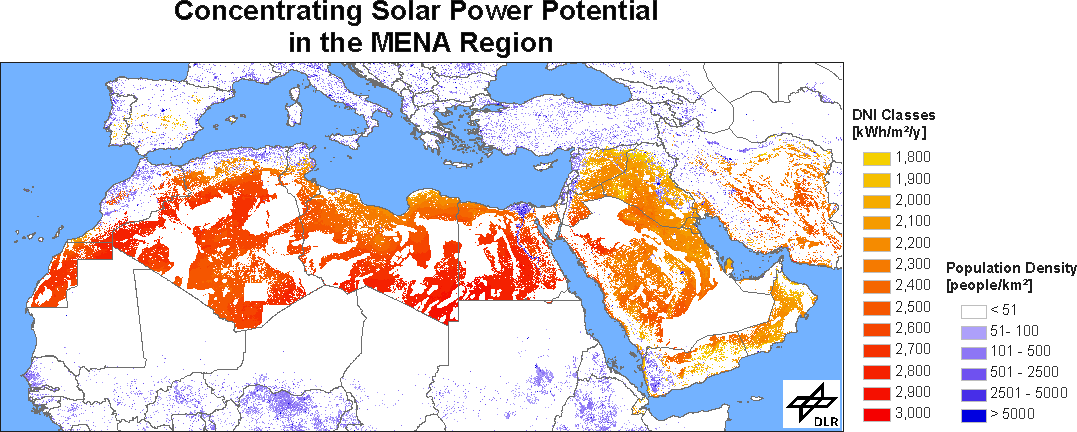- Solar resources in MENA are among the world’s best. The IEA estimates that Africa and the Middle East would need 84 GW of STE by 2030.
- Demand doubles every 10 years throughout the MENA region. The result is a constant struggle to cover peak demand, which often occurs after sunset. STE with storage is a recognized, sustainable answer to address this challenge. As a secure electricity supply, STE also provides a prerequisite for economic development and growth, which are essential for political stability in the MENA countries. Ultimately, increasing the standard of living and stability in the EU’s Southern Neighbourhood is crucial for European cooperation policy and security.
- With the upcoming Paris climate conference, the EU also has a responsibility to live up to its leading role in global climate policy. Supporting renewables in the MENA countries is an opportunity to do so.
- A market for STE in the neighbouring MENA region would be an opportunity for the European industry to create green jobs there and at home in Europe.
Technically, it would only take 0.04 of the solar energy from the Sahara Desert to cover the electricity demand of Europe (E28). Just 2% of the Sahara’s land area could supply the world’s electricity needs. This concept is staggering. With the growth of STE technology into a large scale application, electricity export from Northern Africa to Western Europe is viable option. However, it requires massive investment in large, landmark plants and high voltage transmission lines which dramatically reduce transmission losses.
STE for Mediterranean region
The Middle East and North Africa (MENA) region is emerging as an attractive destination for STE deployment. The MENA region has amongst the world’s best solar resources for STE: abundant sunshine, low precipitation, plenty of unused flat land close to transmission grids. Usually water is scarce in these sunny regions. In light of a study[1] carried out by the German Aerospace Centre (DLR) in order to identify the potential for STE development for both solar thermal electricity and desalination production in MENA countries, STE with the option of thermal storage and hybridisation allows a flexible operation of power and desalination plant. Below is the map illustrating the direct normal irradiance (DNI) at potentially suitable areas for combined STE and desalination plants in the MENA countries.

The IEA estimates that Africa and the Middle East would need 84 GW of solar thermal electricity generation by 2030. Demand doubles every decade throughout the MENA region. The result is a constant struggle to cover peak demand, which often occurs after sunset. STE with storage is a recognized and sustainable answer to address this challenge. As a secure electricity supply, STE also provides a prerequisite for economic development and growth, which are essential for political stability in the MENA countries. Ultimately, increasing the standard of living and stability in the EU’s Southern Neighbourhood is crucial for European cooperation policy and security. A market for STE in the neighbouring MENA region would be an opportunity for the European industry to create green jobs there and at home in Europe.
Current targets for STE deployment indicate strong growth in the coming decades, driven by a motivation to create local employment. According to IRENA and a World Bank report conducted by Ernst Young and Fraunhofer, MENA countries have adopted different measures to develop appropriate policies and instruments to localise the value chain and provide more domestic employment opportunities. The highest local content for STE would likely be achieved in areas such as construction, fabrication of metal structures, mirrors, float glass and certain engineering tasks.
The commercial STE deployment in the MENA region is growing, with the completion of Shams 1 (100 MW, Parabolic Trough) in the United Arab Emirates, Noor I (160 MW, Parabolic Trough, under construction) in Morocco, and the progression of Noor II (200 MW, Parabolic Trough) and Noor III (150 MW, Tower) that have been awarded. The Shagaya project (50 MW, Parabolic Trough) with 10-hour storage and dry cooling has also been awarded in Kuwait and ambitious plans in Saudi Arabia are foreseen with a target of 25 GW by 2040.



